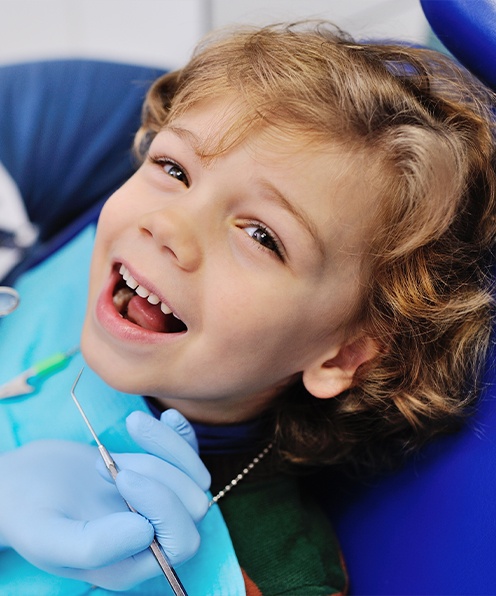Pediatric Dentistry – Buffalo Grove, IL
The Ticket to
a Healthy Smile
Quality dental care from a young age can have a positive impact on not just your child’s health, but their overall confidence and quality of life too! Here in Buffalo Grove, our pediatric dentistry team is ready to make a difference. Don’t hesitate to contact us today if you have any questions, or if you’re ready to set up a first visit for your son or daughter to receive pediatric dentistry in Buffalo Grove, IL.
Why Choose Capezio Pediatric Dentistry for Your Child?
- Positive, Enjoyable Dental Experiences for Children
- We Accept Most PPO Dental Insurances
- Community-Trusted Pediatric Dental Office
Dental Checkups & Teeth Cleanings

It’s recommended by the American Academy of Pediatric Dentistry that you begin bringing your child in for bi-annual checkups and cleanings by the time they turn one year old, or whenever their first tooth grows in—whichever comes first! These initial visits are a great opportunity to help your child create a positive relationship with our dental office and staff, making them excited to learn more about their oral health and come in for their routine visits. If your child is due for a checkup and cleaning, call our dental office today!
Learn More About Dental Checkups & Teeth Cleanings
Tooth-Colored Fillings

Cavities develop due to a buildup of plaque and bacteria in the mouth, leading to enamel erosion and eventually decay. If we spot any signs of cavity formation during your little one’s checkup, we’ll treat it by removing any debris and fill it using composite resin. This will seal off the interior of the tooth from harmful oral bacteria and keep the cavity from developing into an infection that requires pulp therapy.
Several factors influence the performance, durability, longevity, and expense of dental restorations, including:
- The components used in the filling material
- The amount of tooth structure remaining
- Where and how the filling is placed
- The chewing load that the tooth will have to bear
- Before your child’s treatment begins, Dr. Ted will discuss all options and help you choose the best filling for your child’s particular case.
Tooth Extractions

There are times when it is necessary to remove a tooth. Sometimes a baby tooth is delayed from falling out as it should, and the tooth must be removed to make way for the permanent tooth to erupt. Other times, a tooth may have so much decay that it puts the surrounding teeth and jaw at risk. Infection, orthodontic correction or problems with a wisdom tooth can also require removal of a tooth.
If it is determined that your child’s tooth needs to be removed, Dr. Capezio will likely extract it using only local anesthesia (novocaine) and your child won’t see the needle. The procedure is surprisingly fast and kids resume their normal activity the same day.
Learn More About Tooth Extractions
Dental Crowns

A crown is a restoration that covers the entire surface of a decayed or broken tooth. Think of it as a hat. It protects the baby tooth from fracturing until it naturally falls out. The crown will fall out together with the tooth when natural shedding occurs. Crowns can be used on both front and back teeth. On baby molars, a stainless steel crown is used for strength. For front teeth, we can use a resin-based crown that is tooth-colored.
Learn More About Dental Crowns
Pulp Therapy

The pulp of a tooth is the inner, central core of the tooth. The pulp contains nerves and blood vessels. The purpose of pulp therapy in Pediatric Dentistry is to maintain the vitality of the affected tooth so the tooth is not lost and stays healthy until it naturally sheds.
Cavities and traumatic injury are the main reasons for a tooth to require pulp therapy. Pulp therapy is often referred to as a “nerve treatment”, “children’s root canal”, “pulpectomy” or “pulpotomy”. The two common forms of pulp therapy in children’s teeth are the pulpotomy and pulpectomy.
The most common treatment is a pulpotomy. The diseased pulp tissue within the crown (top) portion of the tooth is removed. Next, an agent is placed to prevent bacterial growth and to calm the remaining nerve tissue. This is followed by a final restoration (usually a crown/cap).
A pulpectomy is required when the entire pulp is involved (into the root canals of the tooth.) During this treatment, the diseased pulp tissue is completely removed from both the crown and root. The canals are cleansed, disinfected and, in the case of baby teeth, filled with a resorbable material. Then a final restoration is placed. A permanent tooth would be filled with a non-absorbing material. This is known as a root canal.
My Child is
Afraid of Shots

This is very common and something that Dr. Capezio deals with every day. They've never had a patient say, “I couldn’t wait to get here for you to give me a shot!”
We acknowledge each patient’s fears and tell them that it is normal to be nervous. We just ask that they try their best to cooperate. We explain things to them in a simple manner without using the words “shot” or “needle”, and we encourage you to leave it to us to answer their questions. If your child is asking you about what to expect, please tell them that Dr. Ted does this with kids every day and will explain everything and make it easy for them. That’s all we want you to tell your child.
Dr. Capezio will initially use a Q-Tip to dab on a jelly-like topical anesthetic to the gum. This soaks in for thirty seconds and is followed by a drink of water. We then will distract your child by continually talking to them while simultaneously administering the injection. Your child will never actually see the needle. We know how to move our hands so that your child is focused on the overhead TV and their view of the needle will be obscured.
We tell the kids that they will feel “a little pinch” just before the injection is actually performed. The approach is casual and quick. We then let your child hold a mirror and explain why their mouth feels funny, yet they see that they look normal. Any discomfort from the injection is gone within thirty seconds.
PLEASE REMEMBER IN ALL CASES NOT TO DISCUSS NEEDLES AND SHOTS WITH YOUR CHILD. WE WILL TALK TO THEM THROUGHOUT THE PROCEDURE IN A WAY THAT WILL HELP KEEP THEM CONFIDENT AND RELAXED.
You will receive post-operative instructions for each procedure.
Space Maintenance

Accidents happen that can cause your child to lose a tooth prematurely, like falling off a bike or colliding with someone on the playground’s jungle gym. Even though their teeth were going to fall out anyway, it’s important to preserve the space. Teeth that fall out too early could cause the alignment of their surrounding teeth to change and affect how their permanent teeth will grow in. This can put them at a higher risk of experiencing orthodontic issues when they get older. Our team can place a small space maintainer in their mouth until their other teeth begin naturally falling out to preserve the site.
Types of Space Maintainers

Space maintainers can be made of stainless steel or acrylic and can be removable or fixed. A band-and-loop maintainer is made of stainless steel wire and held in place by a crown or band on the tooth adjacent to the empty space. The wire is attached to the crown or loop and rests against the side of the tooth on the other end of the space. The band-loop space maintainer is cemented onto the teeth.
A lingual arch is used on the lower teeth when the back teeth on both sides of the jaw are lost. A wire is placed on the lingual (tongue) side of the arch and is attached to the tooth in front of the open space on both sides. This prevents the front teeth from shifting backward into the gap. The lingual arch is cemented into place.
At the appropriate time, we will gently remove the fixed space maintainer in a matter of seconds. A removable space maintainer with an attached, artificial tooth can be made for patients born with congenitally absent (missing) front teeth.
Dental Sealants

During your child’s checkup and cleaning, we may recommend dental sealants, also known as preventive resin restoration, as a protective measure to stop cavities from forming. A sealant is a transparent, protective coating that is applied to the chewing surfaces (grooves) of the permanent back teeth, where four out of five cavities in children are found. This sealant acts as a barrier to food, plaque and acid, thus protecting the decay-prone areas of the teeth.
The teeth are cleaned and the sealant resin is painted on and then hardened with a curing light. The sealant procedure is fast, painless and easy. Your child may eat immediately afterward.
Adolescent Dentistry Emergency Kid's Dentistry Orthodontic Referrals

